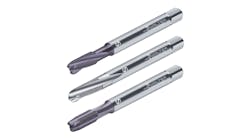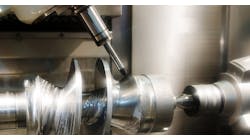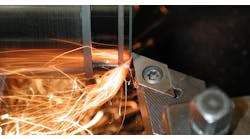The basic engine lathe, one of the most widely used machine tools, is very versatile when used by a skilled machinist. However, it is not particularly efficient when many identical parts must be machined as rapidly as possible. As far back as 1850 there were efforts to develop variations of an engine lathe that could be operated by a relatively unskilled person for mass-producing machined parts. The cutting tools were preset, or "set up" by a skilled machinist, and usually several cutting tools were in operation at the same time, reducing the time spent in machining each part. This is still the basic concept on which mass-production type lathes are based.
The turret lathe and automatic screw machine in their various forms have been developed and improved with the objectives of producing machined parts more rapidly and accurately at lower cost. On most machines of this type, the power available at the spindle has been greatly increased to take advantage of better cutting tool material. Mechanical power, in electrical, hydraulic or pneumatic form, has replaced human muscle power for such functions as feeding tools, operating chucks or collets and feeding bar stock in the machine.
Lathes and Lathe Components
Of the many standard and special types of turning machines that have been built, the most important, most versatile and most widely recognized is the engine lathe. The standard engine lathe is not a high production machine, but it can be readily tooled up for many one-piece or short-run jobs. It is also possible to modify the basic machine for many higher production applications. The modern engine lathe provides a wide range of speeds and feeds which allow optimum settings for almost any operation. There have been advances in headstock design to provide greater strength and rigidity. This allows the use of high-horsepower motors so that heavy cuts with carbide tools are practical. To utilize this high power without losing accuracy, new lathes incorporate heavier beds, wider hardened ways and deeper-sectioned carriages.
Headstock: The headstock is the powered end and is always at the operator's left. This contains the speed changing gears and the revolving, driving spindle, to which any one of several types of work holders is attached. The center of the spindle is hollow so that long bars may be put through it for machining.
Tailstock: The tailstock is non-rotating but on hardened ways, it can be moved, to the left or right, to adjust to the length of the work. It can also be offset for cutting small-angle tapers.
Carriage: The carriage can be moved left or right either by hand wheel or power feed. This provides the motion along the Z axis. During this travel turning cuts are made.
Apron: The apron attached to the front of the carriage, holds most of the control levers. These include the levers that engage and reverse the feed lengthwise (Z axis) or crosswise (X axis), and the lever that engages the threading gears.
Cross Slide: The cross slide is mounted on the carriage and can be moved in and out (X axis) perpendicular to the carriage motion. This is the part that moves when facing cuts are made with power feed, or at any time a cut must be made "square" with the Z axis. This, or the compound, is also used to set the depth of cut when turning. The cross slide can be moved by its hand wheel or by power feed. .
Compound Rest: The compound rest, or compound for short, is mounted on the carriage. It can be moved in and out by its hand wheel for facing or for setting the depth of cut. It can also be rotated 360 degrees and fed by its hand wheel at any angle. The compound does not have any power feed but it always moves longitudinally with the cross slide and the carriage.
Tool Post: The tool post is mounted on the compound rest. This can be any of several varieties but in its simplest form is merely a slotted cylinder that can be moved left or right in the T-slot in the compound and clamped in place. It can also be rotated so as to present the cutter to the work at whatever angle is best for the job.
Bed: The bed of the lathe is its backbone. It must be rigid enough to resist deflection in any direction under load. The bed is made of cast iron or a steel weldment, in a box or I-beam shape, and is supported on legs, a cabinet or a bench.
Ways: The ways of the lathe are the flat or V-shaped surfaces on which the carriage and the tailstock are moved left and right. Each has its separate pair of ways, often one flat surface, for stability, and one V-way for guidance in a perfectly straight line. These ways are hardened and scraped or ground to close tolerances. The basic accuracy of movement of the carriage depends on the ways.
Size: The size of a lathe is specified by two or three dimensions:
• The largest diameter workpiece that will clear the bed of the lathe. The center is the headstock spindle center.
• The largest diameter workpiece that will clear the cross slide is sometimes also specified.
• The longest workpiece that can be held on centers between the headstock and the tailstock.
Turret Lathe
The standard engine lathe is versatile, but it is not a high-production machine. When production requirements are great, more automated turning machines must be used. The turret lathe represents the first step from the engine lathe toward the high production turning machines. The turret lathe is similar to the engine lathe except that tool-holding turrets replace the tailstock and the tool post compound assembly. These machines possess special features that adapt them to production. The "skill of the worker" is built into these machines, making it possible for inexperienced operators to reproduce identical parts. In contrast, the engine lathe requires a skilled operator and requires more time to produce parts that are dimensionally the same.
The principal characteristic of turret lathes is that the tools for consecutive operations are set up for use in the proper sequence. Although skill is required to set and adjust the tools properly, once they are correct, less skill is required to operate the turret lathe. Many parts can be produced before adjustments are necessary. These machines are normally used for small to medium-sized production runs where the engine lathe is too slow but the additional production rate desired does not warrant a special machine.
Square and Hex Turrets: A square turret is mounted on the top of the cross slide and is capable of holding four tools. If several different tools are required, they are set up in sequence and can be quickly indexed and locked in correct working position. So that cuts can be duplicated, the slide is provided with positive stops or feed trips. Likewise, the longitudinal position of the entire assembly may be controlled by positive stops on the left side of the apron. Cuts may be taken with square turret tools and with tools mounted on the hexagon turret simultaneously.
An outstanding feature is the turret in place of the tailstock. This turret mounted on either the sliding ram or the saddle, or on the back of the structure, carries anywhere from 4 to 18 tool stations. The tools are preset for the various operations. The tools are mounted in proper sequence on the various faces of the turret so that as the turret indexes between machining operations, the proper tools are engaged into position. For each tool there is a stop screw or electric/electronic transducer, which controls the distance the tool will feed and cut. When this distance is reached, an automatic trip lever stops further movement of the tool by disengaging the drive clutch.
Like the engine lathe, the modern turret lathe provides fast spindle speeds, wide speed and feed ranges, high power and great rigidity. The machine is operated in the high end of its speed range more than the engine lathe is, partly because the tools placed in the turret often work on small diameters on the workpiece, but also because the operator is more production conscious.
Horizontal Turret Lathes:
Horizontal turret lathes are made in two general designs and are known as the ram and saddle types. The ram-type turret lathe has the turret mounted on a slide or ram that moves back and forth on a saddle clamped to the lathe bed. The saddle-type turret lathe has the turret mounted directly on a saddle, which moves back and forth with the turret.
Vertical Turret Lathes:
A vertical turret lathe resembles a vertical boring mill, but it has the characteristic turret arrangement for holding the tools. It consists of a rotating chuck or table in the horizontal position with the turret mounted above on a cross rail. In addition, there is at least one side head provided with a square turret for holding tools. All tools mounted on the turret or side head have their respective stops set so that the length of cuts can be the same in successive machining cycles. It is, in effect, the same as a turret lathe standing on the headstock end, and it has all the features necessary for the production of duplicate parts. This machine was developed to facilitate mounting, holding and machining of large diameter heavy parts. Only chucking work is done on this kind of machine.
A vertical turret lathe, shown below, is provided with two cutter heads: the swiveling main turret head and the side head. The turret and side heads function in the same manner as the hexagonal and square turrets on a horizontal lathe. To provide for angle cuts both the ram and turret heads may be swiveled 30 degrees right or left of center.
The machine can be provided with a control that permits automatic operation of each head including rate and direction of feed, change in spindle feed, indexing of turret, starting and stopping. Once a cycle of operations is preset and tools are properly adjusted, the operator need only load, unload and start the machine. Production rate is increased over those manually operated machines, because they operate almost continuously and make changes from one operation to another without hesitation or fatigue. By reducing the handling time, and making the cycle automatic, an operator can attend more than one machine.
The turret lathe normally has a jawed chuck to hold the workpiece; however, a collet may be more suitable when producing parts from bar stock. A turning machine equipped with a collet and a turret is called a screw machine, but it is actually a special turret lathe. The special features of screw machines are aimed primarily at reducing idle time on the parts being machined, thereby increasing productivity.
Advantages of Turret Lathes
The difference between the engine and turret lathes is that the turret lathe is adapted to quantity production work, whereas the engine lathe is used primarily for miscellaneous jobbing, tool room or single-operation work.
Automated Equipment
There are turning machines that permit automatic chucking, indexing, feeding, spindle speed changes and other work that has to be done by the operator on the engine lathe. These automatic lathes represent a refinement of the turret lathe, and they are particularly suitable for long run, mass production applications.
Automatic lathes may be made up as single-spindle or multiple-spindle machines. Generally, single-spindle machines provide for turning the workpiece, which is held in a collet or chucked on the headstock. Multiple spindle automatic lathes usually provide means for indexing the workpiece to tools mounted on the various spindles. These tools might include drills, countersinks, boring bars and other rotating cutters. Both single- and multiple-spindle automatics may be made up with vertical as well as horizontal spindle alignment.
As far as the machining processes on an automatic lathe are concerned, the fundamental considerations are the high speeds desired for good productivity, the economics of the cutting process, and the balancing of speeds on various phases of the operation to obtain the desired rate of wear on each cutting tool.
Single-Spindle Automatic Lathes
The majority of single-spindle automatic lathes are designed to machine workpieces that are located between two centers. Some, however, hold the workpiece in a chuck, collet, or specially designed fixture. Most have horizontal spindles. A conventional single-spindle automatic lathe has six major components: base, bed and ways; headstock; work spindle; front tool slide; rear tool slide.
Tooling: Any of the several available workpiece holders that are suitable for the particular application may be used, including chucks, faceplate drives, collets and specially designed fixtures. Chucks, where used, should be power operated to avoid the time lost to manually actuate chucks.
Toolholders are normally designed with slots to locate, and clamps to hold individual cutting tools in their required locations. The assembled toolholders are, in turn, keyed and clamped in a specific location on the front and rear tool slides.
Applications: Axle and transmission shafts, gear blanks, pump drives and pinions are all particularly well suited for machining on single-spindle automatic lathes. In fact, almost any machinable metal part falling within its size capacity that can be chucked, fixtured or run between centers is a potential candidate for this machine. Single-spindle automatic lathes perform turning, facing, chamfering, grooving and forming operations, and are usually used for parts with moderate production rates.
Single-Spindle Automatic Screw Machines
Automatic screw machines are the present-day developments of earlier machines whose only function was the production of screws. Modern machines not only retain thread-cutting capabilities but also are capable of performing all turning operations. These machines produce a wide range of parts from bar stock fed through a hollow work spindle. Some machines are arranged to produce parts from coil stock.
Single-spindle automatic screw machines have horizontal hollow spindles aligned with stock feeding tubes. Most are cam controlled but camless versions, sometimes NC- or CNC-controlled, are more flexible and quickly set up, making them more suitable for shorter production runs. Machines are available in several sizes and have six major components: base, headstock, hollow work spindle, front tool slide, rear tool slide and turret.
The feedrates and motion of tool slides are controlled by cams or hydraulics. Spindle speeds are changed to suit workpiece diameter/material by means of change gears in the machine base. Bar stock is fed automatically to a swing stop, or a turret stop, after each part is completed and cut off. The collet is automatically released during stock advances.
Tooling: Round, square, hex, and other standard-shape collets are available in sizes to suit commercial bar stock sizes. Specials are also made to suit.
Applications: Single-spindle automatic screw machines are used to produce an extremely wide range of small parts including shafts, pins, knobs, screws, bolts and so on, from any machinable metal. Flats and slots can be milled and cross holes drilled. It is normal for one operator to operate several machines, the number depending on the frequency required for reloading bar stock and adjusting or changing tools.
Multiple-Spindle Automatic Bar and Chucking Machines
Conventional multiple-spindle automatic bar and chucking machines have two major advantages over single-spindle automatics-both of which reduce the time required to produce a part:
- The multiple-spindle machine performs work on each of its working stations concurrently; it is also possible to complete a different operation on a part at each position within the same time.
- The maximum time required to complete one piece is the time required for the longest cut, plus index time, and in certain instances the longest cut can be broken up into increments. For example, a drilled hole that is the longest cut of a certain part may be completed in three or more positions.
Part sizes and complexity of design can be accommodated equally well on multi-spindle or single-spindle machines. Shorter changeover time favors single-spindle machines for short production runs, but the shorter machining time per piece of the multi-spindle machine makes it more economical for long runs.
Multiple-Spindle Vertical Automatic Chucking Machines
Multiple-spindle vertical automatic chucking machines are manufactured by several machine tool builders in several sizes and models, ranging from four to eight spindles. One maker supplies a 16-spindle machine that is, in reality double spindles for each position of an 8-spindle machine.
These machines use less floor space than an equivalent horizontal model and are more flexible in application. They do not, however, accept bar stock. Some other advantages are that they are convenient to load, operate and adjust or change tooling.
Computer-Controlled Lathes
In the most advanced lathes, movement and control of the machine and its components are actuated by computer numerical controls (CNC). These lathes are usually equipped with one or more turrets. Each turret is equipped with a variety of tools and performs several operations on different surfaces of the workpiece.
These machines are highly automated, the operations are repetitive, and they maintain the desired accuracy. They are suitable for low to medium volumes of production.
George Schneider, Jr. CMfgE, is the author of Cutting Tool Applications, a handbook to machine tool materials, principles, and designs. He is the Professor Emeritus of Engineering Technology at Lawrence Technological University, and former Chairman of the Detroit Chapter of the Society of Manufacturing Engineers.








